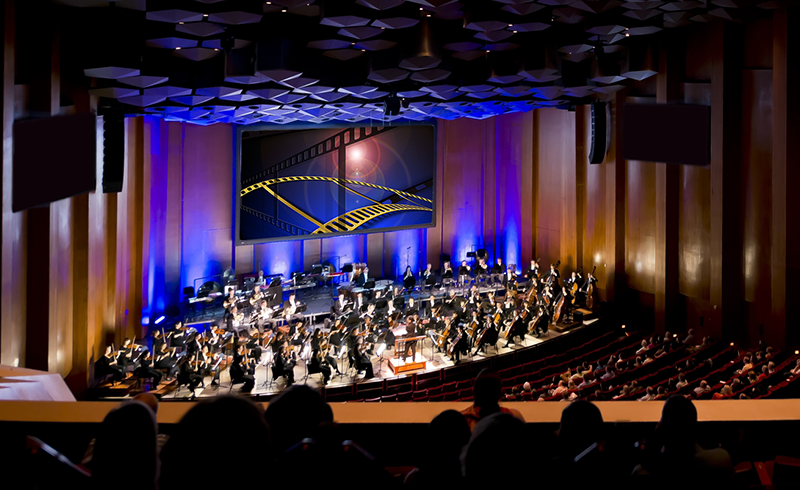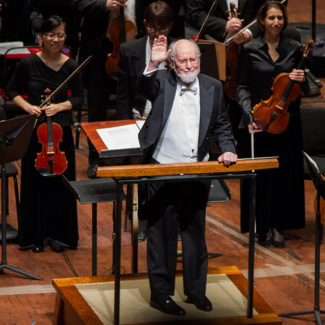
November 9, 2023
LIGHTS, CAMERA, MUSIC! FILM WITH LIVE ORCHESTRA
If you have ever watched part of a movie on mute, you know that without music, scary scenes aren’t as scary, and happy endings aren’t as happy. A live orchestra can take the emotional impact of a film to a whole new level, making suspenseful scenes terrifying, sad moments heartbreaking, and our protagonists’ victories truly ecstatic.
Movies—they’re better with a band
The practice of accompanying a film with live music recalls the glitz and glamour of the silent movie era when lavish premieres would feature music provided by full orchestras. Recently, film with live orchestra has made a surprising comeback due in no small part to increased recognition for Hollywood’s leading composers.

Of those luminaries, the reigning king of film scores is without question John Williams and the Houston Symphony will be performing one of his most popular scores live to picture this holiday season with Harry Potter and the Chamber of Secrets™ in Concert. Just to name a few of his many honors, Williams has won 5 Oscars, 3 Emmy Awards, 4 Golden Globes, and 23 Grammy Awards, and with 50 Academy Award nominations, he is second in history only to Walt Disney (who received 59).
What is the secret of his success? According to Constantine Kitsopoulos, a frequent conductor for Houston Symphony Films with Live Orchestra, “John Williams can write great tunes, but what I especially admire about his writing is his ability to deal with scenes that need the music to create and build tension. It’s how he builds that tension musically and then releases it at just the right moment that I think is masterful.”
Having scored dozens of films, television shows and live events, John Williams has contributed to the soundtrack of modern American life in a way that few can rival—and his instrument of choice is the orchestra.
For film scores, precision is key
Coordinating a live orchestra with a film isn’t easy. The biggest challenge of conducting a Film with Live Orchestra is no matter what happens, the film keeps going. The conductor has to steer the orchestra so that the music always keeps up with the action and anticipate problems before they may or may not happen.
The conductor is ultimately responsible for keeping the orchestra together, but there are also several kinds of technology they can use to keep the music and film in sync. On the conductor’s podium is the written score, a video monitor showing the film, and an earpiece through which the conductor hears what’s called a click track. It’s essentially a metronome that indicates the various tempi of the music. In addition to running the film, the video monitor also displays what are called streamers and punches. Streamers are colored lines that move from left to right on the conductor's video monitor, marking important moments in the music, like a particular moment the conductor should start or end a cue or when tempo changes are going to happen. Punches are white circular flashes that help indicate tempo. These are shown at the beginning of cues and during tempo transitions on every beat within a bar. This is a synchronization system invented by Hollywood composer and conductor Alfred Newman. Technical aids aside, the conductor really has to know the score and how it fits with the movie, especially in the event of a technical mishap. If or when something goes wrong the conductor has to solve the problem instantly so as to keep everything on track.
Behind the scenes
What goes on at the conductor’s podium may be the most visible part of a film with live orchestra presentation, but there are a host of other activities going on out of sight to make sure the performance is a success. Operations Director Becky Brown oversees just about everything that goes on backstage at Houston Symphony concerts, including our film with live orchestra presentations. Another challenge is balancing the sound. Films often have loud sound-effect sequences or uneven dialogue levels that an audio engineer may have to tweak in real-time during a performance.
Besides the music, there is also the projection of the film itself to worry about. A playback station is set up either backstage or in the mezzanine for the engineers who are running the movie. From this position, the technician sends the film onto the screen through special projectors in the film booth. The films themselves run on software that allows the engineer to jump to specific points, which can be helpful during rehearsal when dialogue sections need to be skipped.
This season at Jones Hall movie lovers can look forward to Disney Tim Burton's The Nightmare Before Christmas on December 9 & 10, Disney's EncantoTM in Concert Live to Film on April 20 & 21, Harry Potter and the Chamber of Secrets™ in Concert on May 10 & 11, and Jurassic Park in concert on June 22 & 23 at The Hobby Center. We hope to see you soon!
This blog was originally published on December 18, 2017, and had been edited for marketing purposes.






